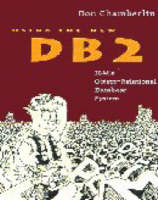
Using the New DB2
IBM's Object-Related Database System
Seiten
2000
Morgan Kaufmann Publishers In (Verlag)
978-1-55860-373-8 (ISBN)
Morgan Kaufmann Publishers In (Verlag)
978-1-55860-373-8 (ISBN)
- Titel ist leider vergriffen;
keine Neuauflage - Artikel merken
"A must read for anyone using, planning to use, or simply curious about V2 of DB2. A beautifully written book that is bound to become the definitive reference for the system. The book covers the new features of the system in a style that is complete, yet not overwhelming. Simply a great book."
"-- David Dewitt, University of Wisconsin" "Using the New DB2" provides: A comprehensive user's guide to DB2 Version 2 for OS/2, Windows/NT, AIX, and other UNIX platforms. Hundreds of tested programming examples, and dozens of practical tips for writing applications. A road map for the merging of relational and object-oriented database technologies. DB2 Version 2 is the most significant enhancement to IBM's database product family since the introduction of IBM's original relational database products. It supports a broad array of Intel- and UNIX-based platforms, and includes many new SQL features. It defines IBM's direction for combining the advantages of relational and object-oriented database technologies in a single system. "Using the New DB2" presents an overview of the basic features of DB2 Version 2, including historical notes on the development of SQL. It then offers a comprehensive explanation of the advanced features of the system, including recursive queries, constraints, triggers, user-defined types and functions, stored procedures, and client-server applications. Several complete sample applications are provided, illustrating storage and manipulation of complex objects, design of an active database, and use of stored procedures. A chapter is devoted to describing tools and procedures for database administrators. Written in an informal and accessiblestyle, "Using the New DB2" is a valuable resource for DB2 application developers, end users, database designers and administrators, as well as for readers with a general interest in database systems and in the convergence of the relational and object-oriented paradigms.
"-- David Dewitt, University of Wisconsin" "Using the New DB2" provides: A comprehensive user's guide to DB2 Version 2 for OS/2, Windows/NT, AIX, and other UNIX platforms. Hundreds of tested programming examples, and dozens of practical tips for writing applications. A road map for the merging of relational and object-oriented database technologies. DB2 Version 2 is the most significant enhancement to IBM's database product family since the introduction of IBM's original relational database products. It supports a broad array of Intel- and UNIX-based platforms, and includes many new SQL features. It defines IBM's direction for combining the advantages of relational and object-oriented database technologies in a single system. "Using the New DB2" presents an overview of the basic features of DB2 Version 2, including historical notes on the development of SQL. It then offers a comprehensive explanation of the advanced features of the system, including recursive queries, constraints, triggers, user-defined types and functions, stored procedures, and client-server applications. Several complete sample applications are provided, illustrating storage and manipulation of complex objects, design of an active database, and use of stored procedures. A chapter is devoted to describing tools and procedures for database administrators. Written in an informal and accessiblestyle, "Using the New DB2" is a valuable resource for DB2 application developers, end users, database designers and administrators, as well as for readers with a general interest in database systems and in the convergence of the relational and object-oriented paradigms.
| Erscheint lt. Verlag | 28.6.2000 |
|---|---|
| Verlagsort | San Francisco |
| Sprache | englisch |
| Maße | 187 x 233 mm |
| Gewicht | 1221 g |
| Themenwelt | Informatik ► Datenbanken ► DB2 |
| ISBN-10 | 1-55860-373-5 / 1558603735 |
| ISBN-13 | 978-1-55860-373-8 / 9781558603738 |
| Zustand | Neuware |
| Haben Sie eine Frage zum Produkt? |